Assessment of Nanosuspension Formulation for Intranasal Administration
Research suggests that intranasal nanosuspensions offer a promising way to formulate and deliver drugs that are poorly soluble in water to patients with chronic conditions.
GiroScience - stock.adobe.com
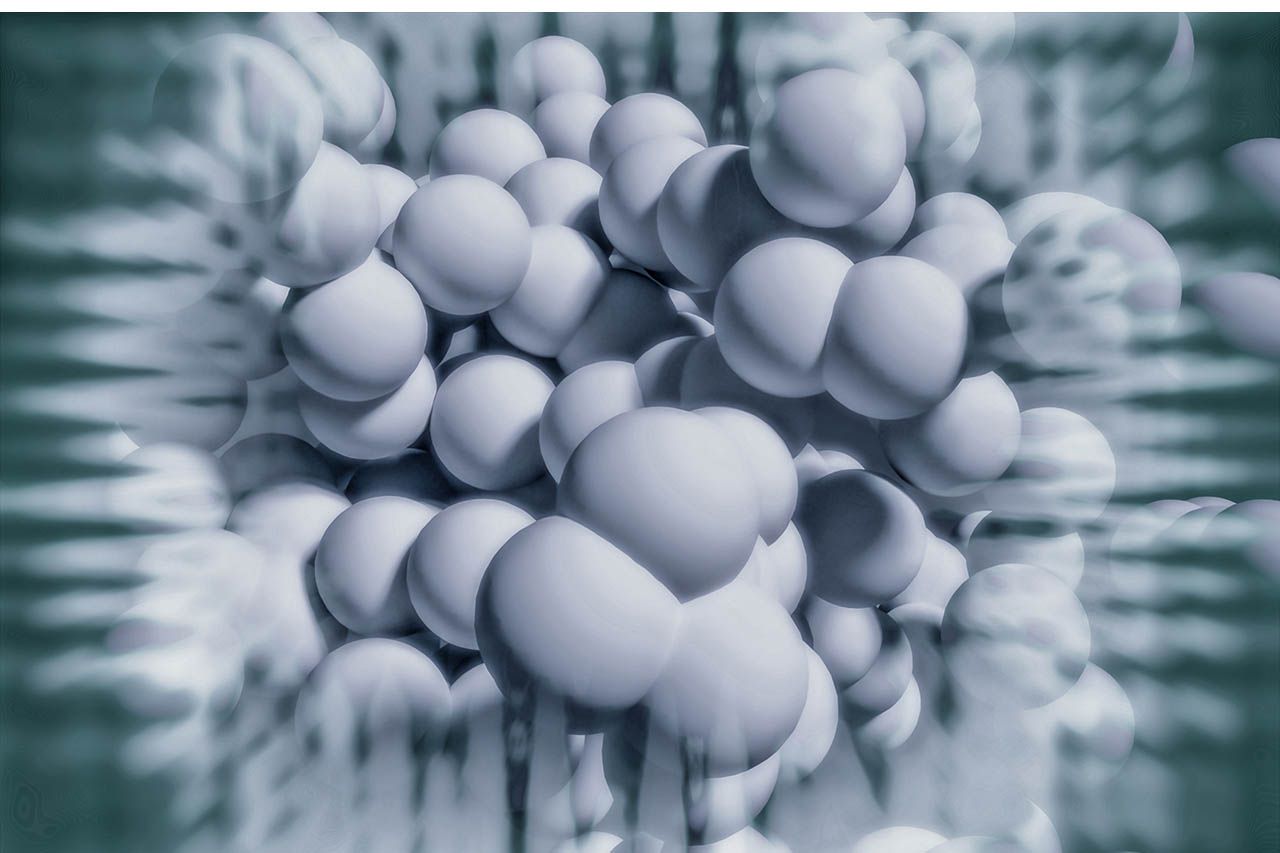
Abstract
This article summarizes research that is underway to develop a stable nanosuspension of celecoxib (CXB), a drug that is poorly soluble in water. Its goals are to assess the impact of a drug’s particle size distribution (PSD) on its pharmacokinetic (PK) parameters following intranasal administration in rats, and to evaluate the feasibility of using an in-line high shear homogenizer (IHSH) to prepare CXB nanosuspensions.
Tests were performed to characterize an optimized prototype formulation based on PSD, crystallinity, pH, osmolality, and shelf-life stability. The suspensions were tested for PK parameters following intranasal administration in adult male Sprague–Dawley rats (n=6/group). The study showed that intranasal administration of nanosized particles demonstrated significant benefit when compared with micron-sized particles for achieving rapid Tmax (i.e., the amount of time that a drug is available in the body at the maximum concentration). Nanosized particles showed better partial areas under the curves (integrals of curves that describe the variation of a drug’s concentration in blood plasma over time).
Introduction
Nasal drug delivery provides an attractive option for local and systemic delivery of many therapeutic agents. This type of drug delivery is non-invasive, painless, and is amenable to self-administration. It also avoids pre-systemic metabolism due to the hepatic first-pass effect, as well as intestinal enzyme inactivation and gastric acid degradation (1–4). Nasal delivery is also a preferred route of administration when faster onset of action is required (e.g.,in the treatment of acute pain, emesis, and other chronic conditions) (5). This route has also been explored for brain drug delivery (6–8).
Solutions are usually the first formulation choice for nasal delivery, but novel drug delivery systems (e.g., nanoparticles, microspheres, liposomes, and dry powders) are also being pursued (9–12).
Despite the progress that has been made in various formulations, intranasal administration of high dosage, poorly water soluble drugs remains challenging. Limited solubility is one problem, especially at relatively small volumes (100–150 µl) of dosage forms to be administered intranasally, and nasal administration also poses constraints with the choice of excipients (e.g., solubilizers, surfactants) that can be used in the formulation.
Solution formulations pose their own inherent challenges, including limited chemical and microbiological stability, whereas nanoparticles, microspheres, and liposomes are associated with low drug loading, lack long-term stability, and are difficult to scale up (8, 13, 14). Of all these formulation approaches, powders can be most conveniently used to deliver high dose, poorly water soluble drug molecules intranasally. However, they are limited by poor wettability, poor flow, and high cohesiveness that hinders their handling, dosing and aerosolization for intransal deposition (10, 12). In addition, permeation enhancers may often be required to improve their permeability through nasal mucosa (15).
Nanosuspensions, defined as dispersion of crystalline particles below 1000 nm dia. in aqueous media, can be used as an alternate formulation strategy for intranasal delivery of poorly water soluble drugs. Nanosuspensions require minimal concentration of stabilizers (e.g., surfactants, polymers, or both), thus they are often referred to as “carrier-free” drug delivery systems (16–18).
Nanosuspension formulations do not contain toxic solubilizers or cosolvents and enable a higher rate of drug dissolution and increased apparent solubility (16, 19), as well as increased adhesiveness to the surface/cell membranes (17), which can be helpful in increasing the retention of particles onto the nasal mucosa. They also facilitate higher drug loading (20), which is particularly advantageous in nasal formulations, due to the limitations of dose volume, and enable more targeted drug delivery (6,14).
Extensive information is available on nanosuspensions (16, 18). The research discussed in this article aims to develop a stable nanosuspension of a poorly water-soluble drug and assess the impact of its particle size distribution (PSD) (micron- vs. nano-sized) on pharmacokinetic (PK) parameters following intranasal administration in rats. CXB, which has an aqueous solubility of 5 μg/mL and logP of 4.01, was selected as the model drug. Another goal for the research was to evaluate feasibility of using an in-line high shear homogenizer (IHSH) to prepare CXB nanosuspension. A systemic study on the absorption enhancement of drug nanosuspensions via a nasal route has not been previously reported, while this study also documents the first use of scalable IHSH to prepare nanosuspensions of a drug.
Materials
CXB was purchased from Hetero Drugs Ltd., based in Visakhapatnam, India. Egg lecithin (Lipoid E80) and sodium oleate were purchased from LIPOID GmbH, based in Germany. Polyoxyethylene-polyoxypropylene block copolymer 188 (Poloxamer 188), Polyvinylpyrrolidine K17 (PVP K17), Polyethylene Glycol 300 (PEG-300), D-α-Tocopheryl polyethylene glycol 1000 succinate (Vitamin E TPGS), Macrogol (15)-hydroxystearate (Solutol HS15), and polyoxyethylene 20 sorbitan monooleate (Polysorbate 20) were purchased from BASF GmbH, Germany. Sodium citrate dihydrate was procured from Merck, Germany. All other chemicals were of analytical-grade or the highest purity grade available.
Methods
CXB suspensions were prepared in two stages. First, coarse CXB suspension was obtained by controlled precipitation of CXB using anti-solvent addition. Antisolvent addition uses a solvent in which the compound of interest is less soluble. Using a mixture of solvent and antisolvent can help result in better control of crystal size in precipitation. In the second stage, the coarse suspension was processed using a high-pressure homogenizer (HPH) to obtain CXB micro- and nano-suspensions. The details of each process step are discussed in the following.
Stage I: Preparation of CXB coarse suspension. Briefly, 5g CXB was dissolved in 30 mL of absolute ethanol to get clear homogenous solution. This solution was then added to 300 mL of 1 % w/v aqueous solution of sodium citrate (the ratio of organic to aqueous phase was 1:10 v/v). The addition was carried out in a drop-wise manner using a 10-mL syringe under overhead stirring at 1000–1500 rpm as shown in Figure 1. This ultimately resulted in the precipitation of CXB in an aqueous solution of sodium citrate. The coarse CXB suspension was then filtered using a 0.2-µm polyvinylidene difluoride (PVDF) membrane filter (Millipore, India). The CXB particles were then washed multiple times with 100 mL of 1% sodium citrate solution to remove ethanol from the formulation. Finally, the CXB bed was re-suspended in aqueous vehicle containing a combination of different stabilizers (discussed in detail in subsequent sections) to get a final volume of 100 mL. The strength of the CXB suspension thus obtained was 50 mg/mL (i.e., 5% w/v), which will be referred to hereafter as coarse suspension of CXB.
Figure 1. Preparation of a coarse suspension of celecoxib (CXB) using overhead stirrer (Stage I).

Stage II: Preparation of CXB micro- and nano-suspension. The coarse CXB suspension (50 mg/mL) was then placed in a high-pressure homogenizer (HPH) (GEA Niro Panda 123, Japan) to obtain CXB microsuspension and nanosuspension. The microsuspension was obtained using one HPH cycle at 1000 bar pressure, while the nanosuspension was obtained using two pre-homogenization cycles at 500 bar followed by thirty cycles at 1000 bar. The product temperature was maintained at 10 ± 5 ºC throughout the process.
In-line high shear homogenizer (IHSH). In another batch, IHSH (Megatron MT 3000, Kinematica, Switzerland) was used instead of an overhead stirrer to prepare a coarse suspension of CXB. The purpose of this step was to evaluate the feasibility of using IHSH for controlled precipitation of CXB in Stage I. The IHSH consists of two stainless-steel containers, which function as reservoirs, one containing 900 mL of aqueous phase suspension (1 % w/v sodium citrate in water) and another containing 90 mL organic phase of suspension (15 g CXB dissolved in 90 mL ethanol). The aqueous phase was kept in circulation mode and the organic phase was added to it via an injection port, as shown in Figure 2. The addition was carried out at a controlled flow rate of 1–2 mL/min near the rotor and stator blade moving at 18000 rpm.
Figure 2. Schematic presentation of an in-line high shear homogenizer (Megatron MT3000) used to prepare coarse suspension of celecoxib (CXB), Stage I.

The entire assembly was provided with water-jacketed facility to keep the product temperature at 10 ± 5 °C. The CXB precipitate obtained at the end of this step was processed (as previously discussed) to obtain coarse CXB suspension 50 mg/mL, which was subsequently processed using Stage II to obtain CXB microsuspension and nanosuspension.
Selection of stabilizers for CXB suspension. Different surfactants/stabilizers were evaluated to obtain CXB particles of nano size with narrow polydispersity index (PDI). Among many, PVP K30, Tween 80, Poloxamer 188, Solutol HS15, Lipoid E80, and TPGS were evaluated as stearic stabilizers. Sodium oleate was evaluated as a charge-based stabilizer, and sodium citrate was used as a hydrotropic agent. Dextrose was added as an osmotic agent.
Characterization of CXB suspension. Particle size analysis – CXB microsuspension was characterized using optical microscopy (ECLIPSE, 50iPoL, Nikon Metrology NV, Germany). Briefly, the 5µL suspension was mounted on a clean glass slide, covered with glass cover slip, and observed under optical mode under 50X magnification. Approximately 300 particles were counted (n = 3), and the average particle size was reported.
The CXB nanosuspension was first characterized using dynamic light scattering (Malvern Zetasizer ZS Nano). Briefly, 0.1 mL of CXB nanosuspension (50 mg/mL) was diluted to 10 mL with 0.6 % w/v solution of Poloxamer 188, mixed well using vortex for one minute, and the sample was then analyzed. Three measurements were taken per sample and results were checked for reproducibility of Zavg value and PDI.
Powder X-ray diffraction (PXRD). Intermediate CXB particles (obtained as precipitate in stage I) and the final CXB suspension (obtained in stage II) were filtered through 0.45-µ nylon filter paper. The CXB particles obtained on the filter paper were allowed to dry at 40 °C overnight in a vacuum oven.
The dried CXB was then subjected to PXRD analysis using a PXRD diffractometer (Bruker Karlsruhe, Baden-Wurttemberg, Germany). The CXB, prior to drying, was used as a reference sample. The samples were scanned over an angular range of 3° to 40° 2θ at a step size of 0.02° and scan rate of 1 s/step. The data were analyzed using DIFFRAC plus EVA software (Bruker Karlsruhe, Baden-Wurttemberg, Germany).
Differential scanning calorimetry (DSC). Original (“as received”) CXB and dried CXB suspension formulations were analyzed by DSC (Q1000, TA Instruments, Delaware USA, data analysis with Universal Analysis, version 4.4A). The device was equipped with a refrigerated cooling accessory, RCS90. Dry nitrogen, at 50 mL/min, was used as the purge gas. Prior to analysis, the instrument was calibrated for temperature and heat flow with high-purity indium used as a standard. Approximately 3–5 mg of CXB powder were weighed in a Tzero aluminum pan and hermetically sealed. The sample was then heated from 30 °C to 290 °Cat a heating rate of 10 °C/min. The analysis was carried out in triplicate.
High-pressure liquid chromatography (HPLC). HPLC (Shimadzu Corporation, Kyoto, Japan) was used to quantify the CXB content in the prepared formulations. Class VP (Release 6.10) software was used to collect and analyze the resulting data. A Beta basic phenyl column (Particle size: 5µm, 250 × 4.6mm, Metachem, Torrance, CA) was used for separation, and the peak area was detected at a wavelength of 248 nm using a diode array detector. The flow rate was 1.5 mL/min, and an injection volume of 20 µL was used. The total run time was 45 minutes. The mobile phase consisted of Phase A, 2.7 gm of potassium dihydrogen phosphate dissolved in 1000 mL of water, and the pH was adjusted to 3.0 with orthophosphoric acid. Phase B was methanol.
The gradient profile (including equilibration) used was: 55% A–45% B (v/v) for 0.01 min; 55% A–45% B to 51% A– 49% B in 25 min; 51% A– 49% B to 15% A– 85% B in 2 min. and held for 10 min., then back to 55% A–45% B in 3 min. and held for 5 min.
The samples were prepared using tetrahydrofuran as diluent 1 and a methanol-water mixture (70:30) as diluent 2 in a ratio of 20 diluent 1 :80 diluent 2. The calibration was performed in the linearity range of 1-32 µg/mL.
Stability studies. Short- vs. long-term stability. Short-term or preliminary stability (i.e., one month) and long-term stability (i.e., 12 months) studies were carried out for different compositions of CXB nanosuspension at 2–8 ⁰C and 25 ⁰C/60% relative humidity (RH). Briefly, 3 mL suspension was filled in 5-mL clear United States Pharmacopeia (USP) type-I glass vials. The vials were closed with bromobutyl rubber closers, crimped with aluminium flip off caps, and placed in stability chambers (Newtronic walk-in stability chamber, India). The suspensions were then evaluated for ease of redispersibility upon gentle inverted and upright shaking; PSD, size distribution; pH (using a pH bench-top meter, Orion star A211, Thermo Fisher Scientific, Waltham, MA USA); osmolality (using the Osmomat 030D device, Gonotec, Meß- und Regeltechnik GmbH, Germany); and for the amount of CXB in the formulation.
In-vivo studies. Healthy young adult male Sprague–Dawley rats weighing 240–260 g were used in animal studies. The rats were housed in a cleanroom kept at 21–25 °C, with RH of 50–60%, and a constant 12-h light/dark cycle. Guidelines established by the Committee for the Purpose of Control and Supervision of Experiments on Animals (CPCSEA) were followed in this study, and the protocol was approved by Suven Life Sciences’ Institutional Animal Ethics Committee (IAEC approval No. PK-PRO-701-13) in Hyderabad, India.
CXB suspensions (micro- and nano-suspension) were administered intranasally to rats under brief isofluorane anaesthesia using PE10 tubing connected to a Hamilton syringe. Rats were kept in a supine position with their nostrils facing upwards. Approximately 25 μL of the formulation was administered to each nostril within 45 seconds (21). Blood samples were collected pre-dose, and at time intervals of 0.03, 0.08, 0.25, 0.5, 1, 2, 4, 6, 8, and 24 hr. At each time point, roughly 0.2 mL of blood was collected into the tube, which contained the anticoagulant, heparin. Blood samples were centrifuged at 5000 rpm for 5 min, and plasma was harvested and stored at -70 °C until analysis. Plasma CXB levels were estimated using fit-for-purpose liquid chromatography (LC)-mass spectrometry (MS)/MS methods. PK parameters were estimated by non-compartmental analysis (NCA) using Phoenix WinNonlin 6.3 software.
As an internal standard, 22.5 µL plasma was sampled and mixed with 150 µL acetonitrile containing 1.0 µg/mL diclofenac. The resulting sample was subjected to vortex for 1 min, and then to centrifugation at 10,000 rpm for approximately 10 min at a temperature of 10 °C ± 1 °C. The supernatant clear solutions were transferred to labeled vials, and about 2.0 µL of the sample solution was injected to chromatographic column (XBridgeTM C18 3.5 µm 4.6*100 mm). The mobile phase consisted of A: 10 mM ammonium formate (0.2% formic acid v/v) and B: Acetonitrile. The gradient profile (including equilibration) was used: 60% A–40% B (v/v) for 0.01 min and held for 0.19 min.; 60% A–40% B to 5% A– 95% B in 1 min and held for 1.5 min; 5% A– 95% B to 60% A–40% B in 2.51 min and held for 1 min. The total run time was 3.5 min, and a flow rate of 1.2 mL/min was used. The calibration was performed in the linearity range of 10.74–10744.24 ng/mL.
Results and discussion
Preparation and optimization of CXB nanosuspension. Nanosuspension stabilization is the most critical part of the formulation and a prerequisite for formulation development. CXB nanosuspension was prepared and optimized using various stabilizers (e.g., surfactants and polymeric stabilizers). Surfactants act by coating the nanocrystal surface, thereby wetting them and reduce their aggregation on storage. The mechanism cited for improved stability of the nanosuspension is to provide repulsive forces among the drug nanoparticles, either by electrostatic or steric stabilization (16, 22). The electrostatic stabilization can be provided by adsorbing ionic surfactants or charged polymers, whereas steric stabilization can be provided by adsorbing the nanoparticles with non-ionic surfactants/polymers such as hydroxypropyl methylcellulose (HPMC), Hydroxypropyl cellulose (HPC), PVP, and copolymers such as Pluronics (18, 23). Generally, the best combination of both approaches will enable optimal stabilization. Stabilizers from each category were evaluated alone and in combination to prepare CXB nanosuspension.
Table I shows different formulation compositions that were evaluated for generation of CXB nanosuspension.
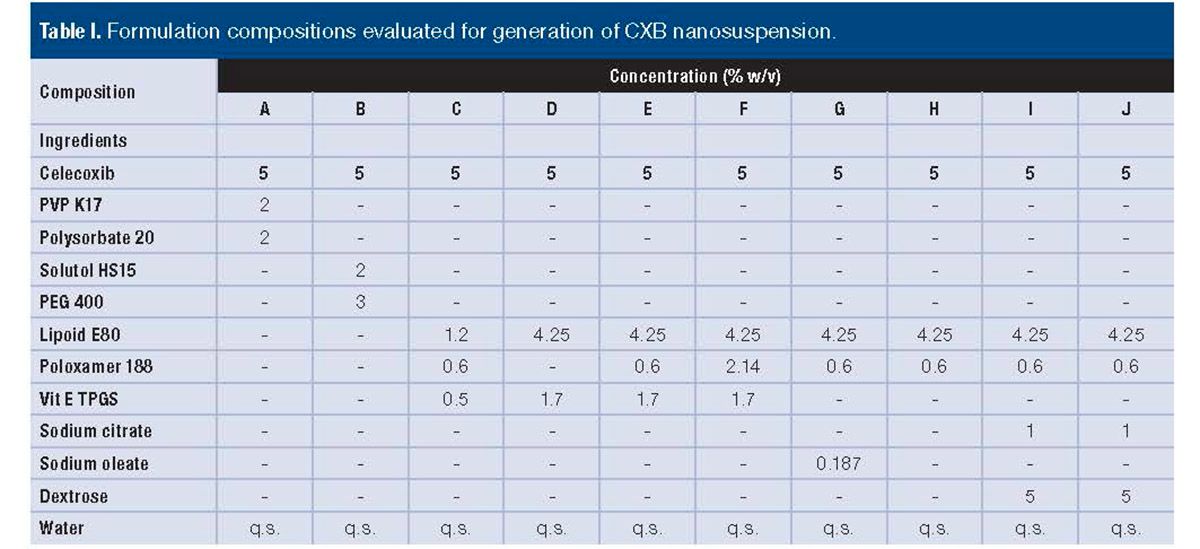
The results of particle size analysis are shown in Figure 3.
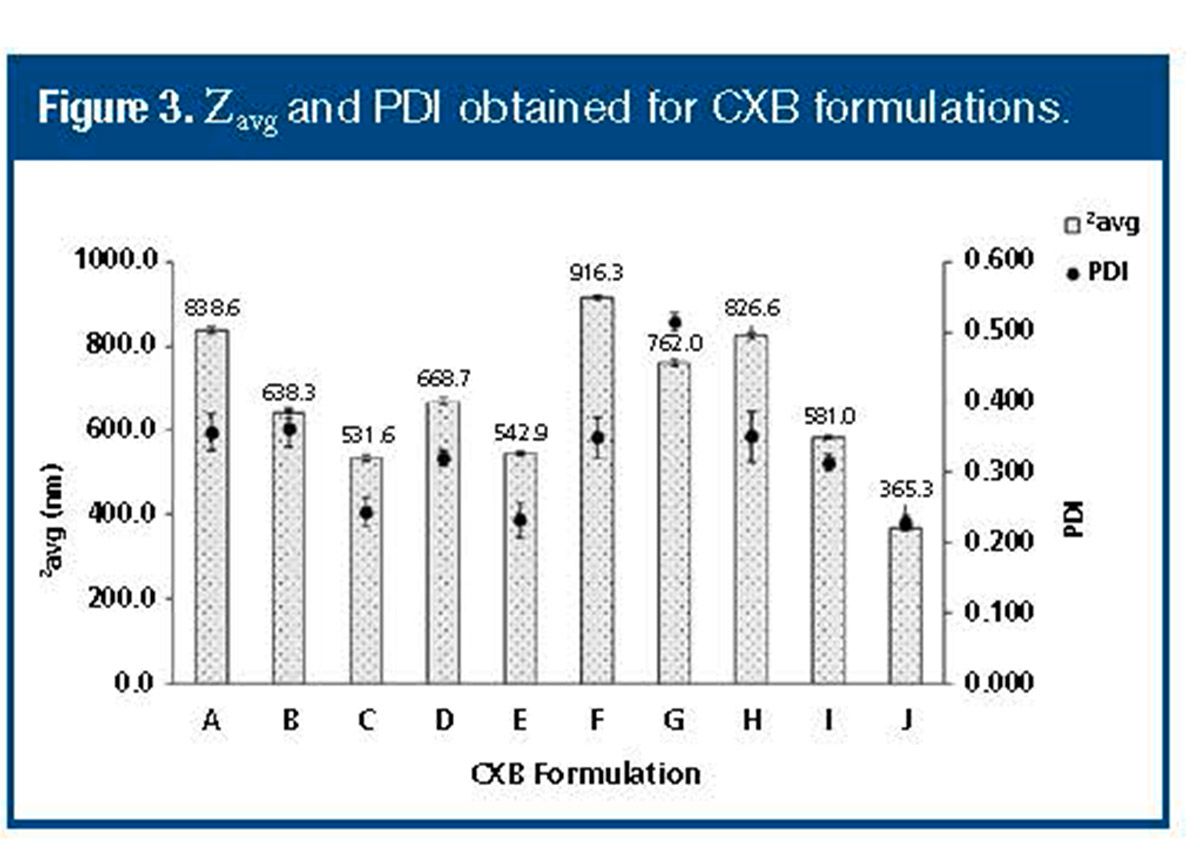
Combinations of non-ionic surfactants(e.g., polysorbate 20, Solutol HS15) and polymeric stabilizers (PVPK17 and PEG 400) lead to generation of CXB nanocrystals with Zavg in range of 600–800 nm with high PDI of 0.34-0.38 (formulation A and B).
Next, the other non-ionic surfactants (Vit E TPGS and Poloxamer 188) were tried in combination with phospholipid based surfactant (Lipoid E80). The combinations led to generation of CXB nanocrystals with Zavg of 500–670 nm and reduced PDI to 0.2–0.3 (formulation C, D, and E). The reduced particle size and narrow PDI could have resulted from the combined effect of charge and steric stabilization of CXB nanoparticles (23). Lipoid E80, which is an ionic stabilizer, is expected to impart a negative charge to the CXB particle surface due to presence of phosphatidylserine and inositol. On the other hand, Poloxamer 188 and TPGS, both being non-ionic surfactants, stabilize the nanocrystals by stearic hindrance (23).
A critical analysis of the formulations C, D, and E revealed that Poloxamer 188 had a significant impact on PSD when it was used in combination with Lipoid E80. Removing the Poloxamer, as in formulation D, showed increased Zavg and PDI compared to formulation C and E. Concentration of Poloxamer was another important factor governing PSD. Increasing the Poloxamer concentration above 0.6 % w/v resulted an increase in Zavg (from 542.9± 4.8nm to 916.3 ± 5.9 nm, formulation E vs F). This could be due to aggregation of CXB nanocrystals due to the formation of bridges between the polymeric chains covering the nanocrystals and the excess polymeric chains present in solution. The formulations C, D, and E were used for further optimization.
Preliminary stability studies revealed that formulation C, D, and E led to formation of non-dispersible albeit at the cost of increased particle size as shown in formulation G and H (Figure 3). This underscored the need to replace TPGS with an alternative stabilizer in formulations that contained Poloxamer and Lipoid E80.
Sodium citrate was used as an alternate stabilizer to TPGS. Sodium citrate may act as a hydrotropic agent because it enables improved wettability of CXB in the aqueous media (24) and it may function as a flocculating agent and provide controlled flocculation of the nanosuspension, thus improving long-term storage stability (25).
Addition of sodium citrate (Formulation I) not only brought down the Zavg (581nm) but also led to the formation of easily re-dispersible stable nanosuspension. This research documents the use of sodium citrate as a hydrotropic agent for the first time, which not only reduced PSD but significantly improved the stability of liquid nanosuspensions. As a result, Formulation I was selected as the prototype formulation, and the formulation composition was used to prepare the microsuspension, study the impact of IHSH, and characterize the solid form of CXB and assess long-term storage stability.
Impact of an IHSH on CXB particle size. The particle size of starting material (as obtained in coarse suspension of CXB) may have a significant impact on the size of nanocrystals prepared using milling processes such as HPH or media milling (26). It was hypothesized that use of high shear or high stirring speed in Stage I may lead to controlled PSD of precipitated CXB particles. This ultimately led to further particle size reduction and narrower PSD of the nanosuspension prepared during Stage II. Therefore, the overhead stirrer was replaced by the IHSH in Stage I to prepare the coarse CXB suspension. Use of an IHSH enabled high shear as well as high stirring speed, with the rotor and stator blade moving at 18,000–20,000 rpm (see Figure 2). Moreover, the IHSH was run on automatic mode with continuous in-line precipitation of CXB and kept on continuous circulation mode throughout the process.
Microscopy revealed that precipitated CXB particles obtained using an IHSH were smaller (5–10 µm in diameter) and more uniform compared to those obtained using the overhead stirrer (15–20 µm, data not shown). Further, the IHSH-processed materials showed minimum aggregation of precipitated particles. This may have been due to in-line precipitation and continuous circulation mode of aqueous phase compared to static behavior of the aqueous phase under overhead stirrer (Figure 1 vs. Figure 2). The coarse CXB suspension thus obtained using IHSH was processed further using Stage II to obtain the CXB nanosuspension. The reduced PSD of precipitated CXB particles ultimately led to significant size reduction. The Zavg was reduced from 581.0 nm to 365.3 nm, whereas PDI was reduced from 0.31 to 0.22 (formulation I vs J, Figure 3). This clearly shows that a high stirring speed of 18000 rpm and the high shear provided by the rotor and stator head in an IHSH have a significant impact on particle size.
An in-line high shear homogenizer, the Megatron MT 3000 has a liquid circulation capacity of 10–15 l/min and is capable of providing rotor speeds of up to 30,000 rpm (27). Thus, the process is more practical and scalable than the overhead stirring process. Although ample research has been performed on nanosuspensions that were prepared using the antisolvent approach, applicability of these processes is limited by the formulation’s scalability.
Solid state characterization. PXRD and DSC were used to confirm the solid form of CXB present in nanosuspension formulation. CXB exists in four different polymorphic forms, of which form III is the most stable (28). Figure 4 shows PXRD pattern obtained for as received CXB (pure form III), precipitated CXB, placebo (obtained by physically mixing dried excipients in proportion used in formulation I), and CXB nanosuspension.
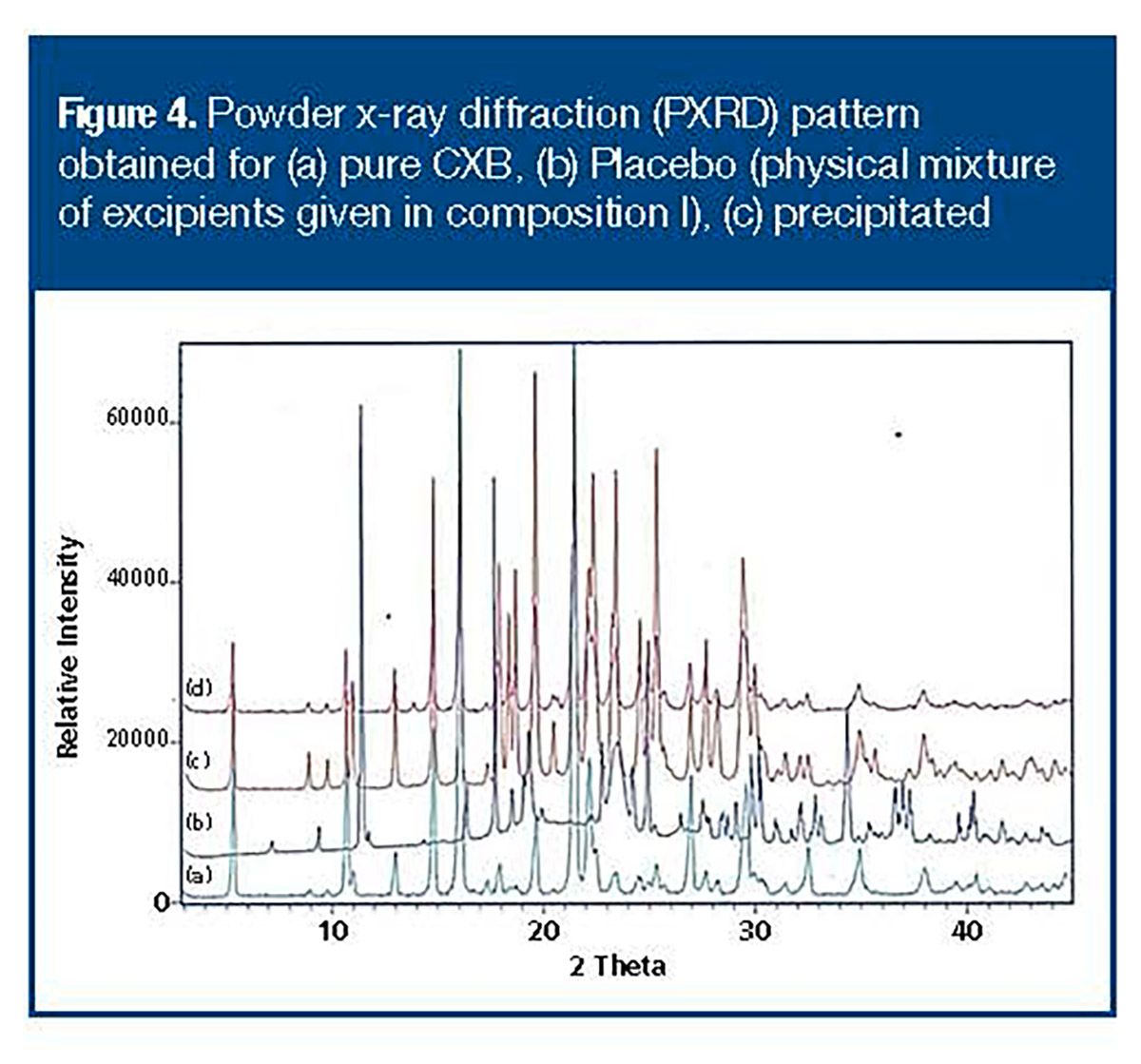
Both precipitated CXB and CXB nanosuspension formulations showed PXRD patterns similar to that of as received CXB. Presence of a characteristic crystalline peak at the 2θ value of 5° indicated the presence of CXB form III in nanosuspension (28). This confirmed that no polymorphic transformation was observed either during the precipitation step (Stage I) or during HPH (Stage II). Furthermore, the presence of a single melting endotherm at 161.81 °C (midset) in DSC thermograms confirmed the presence of polymorphic form III in CXB nanosuspension (Figure 5).
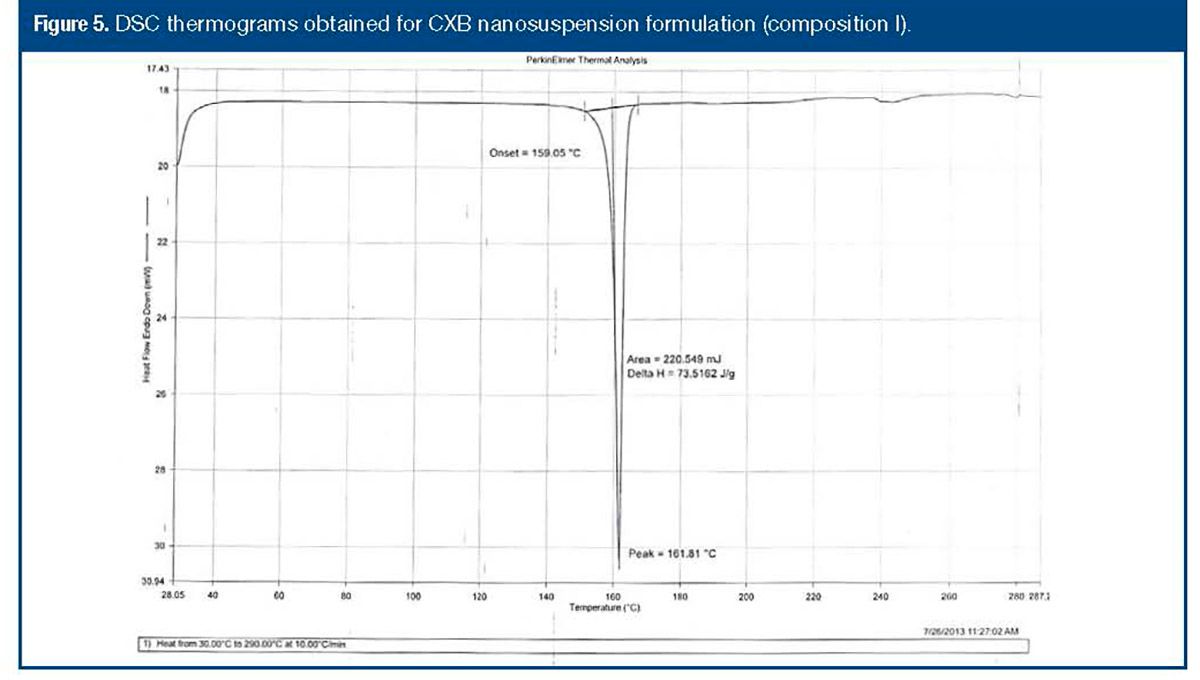
Stability evaluation of CXB nanosuspension formulation. Preliminary stability studies (data not shown) revealed that all nanosuspension formulations except I showed formation of non-dispersible cake on storage at 2–8 °C and 25 ⁰C/60% RH at the end of one month. Composition I was found stable for three months at 25 ⁰C/ 60% RH and for 12 months at 2–8 ºC.
Figure 6 shows the stability profile of Formulation I obtained at 2–8 °C. Further, the composition showed CXB content in the range of 100 ± 5 % with insignificant increase in total impurity at the end of 12 months. The suspension showed osmolality of 330 ± 20 mOsmol/Kg.
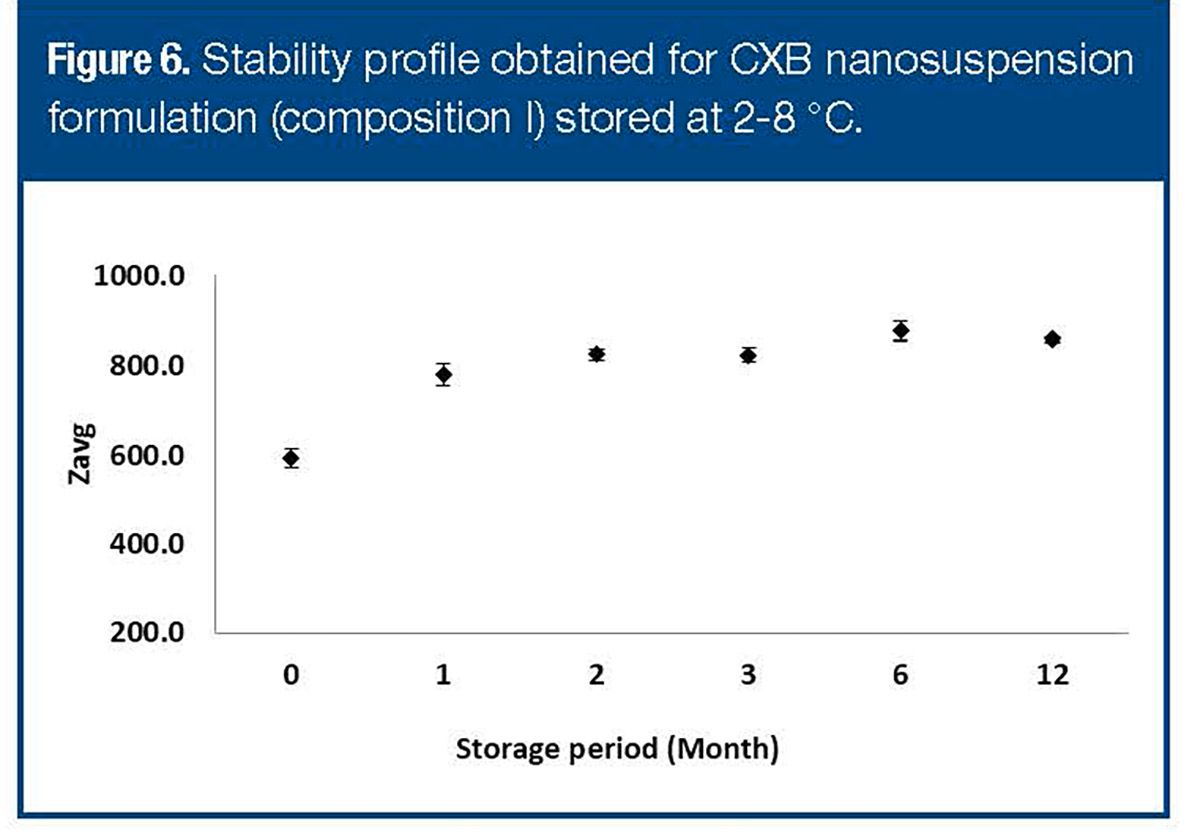
Here, formation of non-dispersible cake by composition I at 25 ⁰C and 60 % RH could have been due to the generation of free fatty acids caused by the degradation of Lipoid E80, coupled with coalescence of lipoidal vesicles observed at high temperature (29).
Research has shown that Lipoid E80-stabilized itraconazole suspension is stable at 5 ⁰C in contrast to 50 ⁰C (29). This was further supported by a slight decrease in the pH of the CXB nanosuspension on stability due to generation of free fatty acids in the formulation. The decrease in pH was rapid at 25 ºC/60% RH compared to 2–8 ºC, with overall pH remaining above 5 at both stability conditions (Figure 7).
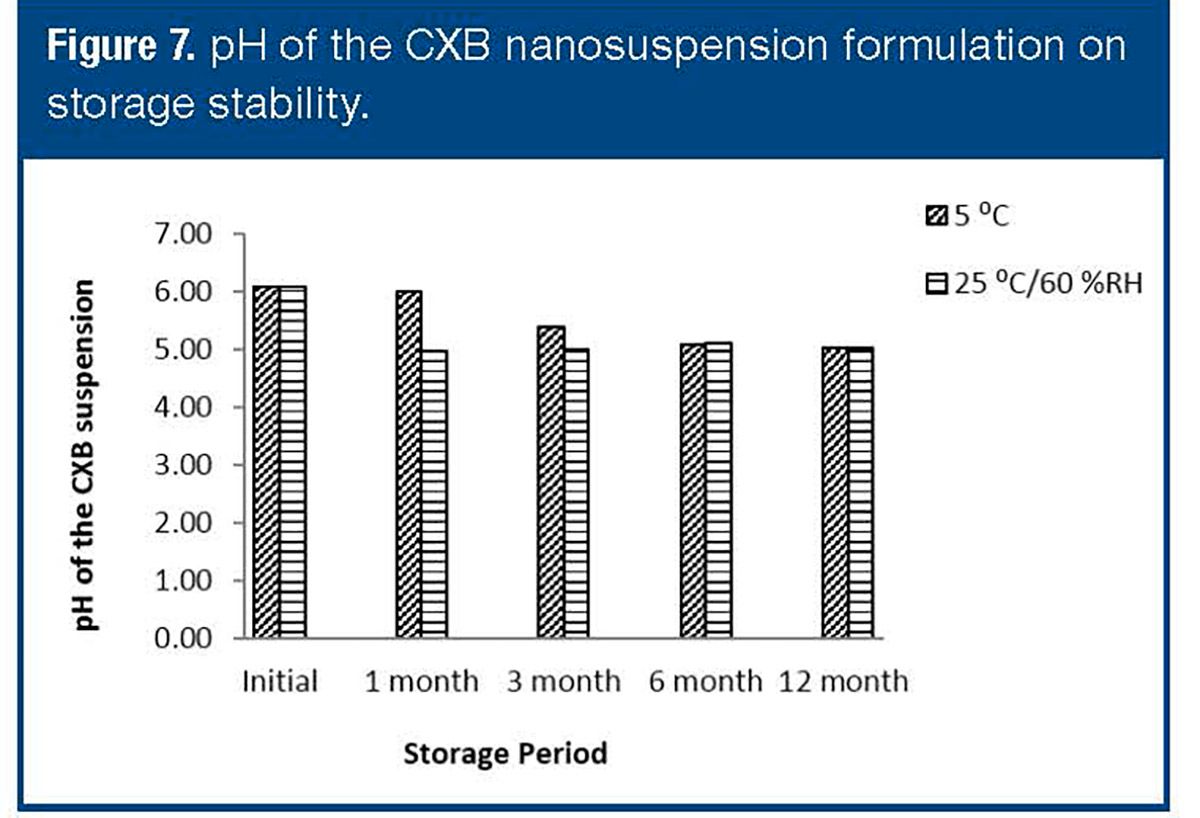
Further, the dissolved content of CXB in stable nanosuspension formulation determined using HPLC showed that CXB dissolved up to 2 mg/mL, which remained constant at all stability time points. This clearly indicate that the Ostwald’s ripening was very low, thereby leading to formation of stable nanosuspension at 2–8 °C.
In-vivo evaluation. CXB microsuspension (particle size of 3 ± 2 um, Figure 8) and nanosuspension (Zavg of 365.3 ± 3.5 nm), both prepared using formulation composition I, were used for in-vivo studies. Results from rat PK studies revealed that the particle size of the administered suspension significantly impacts the PK parameters following intranasal delivery.
Figure 8. Microscopy images of celecoxib microsuspension observed under 400X magnification. The suspension revealed average particle size of 3 ±2 µm.

For the same dose, the nanosuspension formulation demonstrated significantly (P<0.01) superior Tmax value (3 hours) compared to microsuspension formulation (6 hours) (Table II, Figure 9).

Further, the nanosuspension have better partial AUC (i.e. area under the curve, which describes variation in a drug’s concentration in blood plasma over time) compared to microsuspension following intranasal delivery.
The particle size may have significant impact on dissolution kinetics, thereby affecting the total amount of dissolved drug at the site of administration. Nanocrystals, by virtue of their ability to increase apparent solubility, improve dissolution, and increase permeability, may lead to faster onset of action compared to microsuspension (30). Studies have shown that the rate and extent of CXB dissolution is an inverse function of particle size (31).
The study demonstrated a dramatic increase in the rate and extent of dissolution for CXB nanosuspension stabilized by Tween 80 compared to micronized CXB. Interestingly, the slope of the dissolution profile was significantly different for the nanosuspension in the first 10 minutes and became almost equal for both formulation at a later stage. Other experiments reported similar results, wherein CXB nanosuspension showed significant increase in dissolution velocities (more than 80% drug dissolved) compared to coarse CXB powder (27.9% drug dissolved) in the first 10 minutes (31).
From the perspective of intranasal drug delivery, the difference in the rate and extent of dissolution of CXB in first 10 minutes becomes significant because the overall residence time of the formulation in the nasal cavity is approximately 15–30 minutes. Any dissolution within this period allows more drug to be available in solution form, thus facilitating the absorption process.
The authors of the study explain that the nanosuspension of CXB demonstrated a higher surface-to-volume ratio that enables hydration over a larger surface area, thus offering a greater potential for increased drug dissolution (30). In these studies, even though particle size significantly affected the Tmax of CXB, other parameters such as Cmax and AUC remained similar in both formulations. This may be due to drainage of the unabsorbed drug from the nasal cavity into the gastrointestinal tract, where absorption for both the formulation remains similar. However, statistically significant differences (P<0.01) were observed in the partial AUCs of the formulations as in Table II.
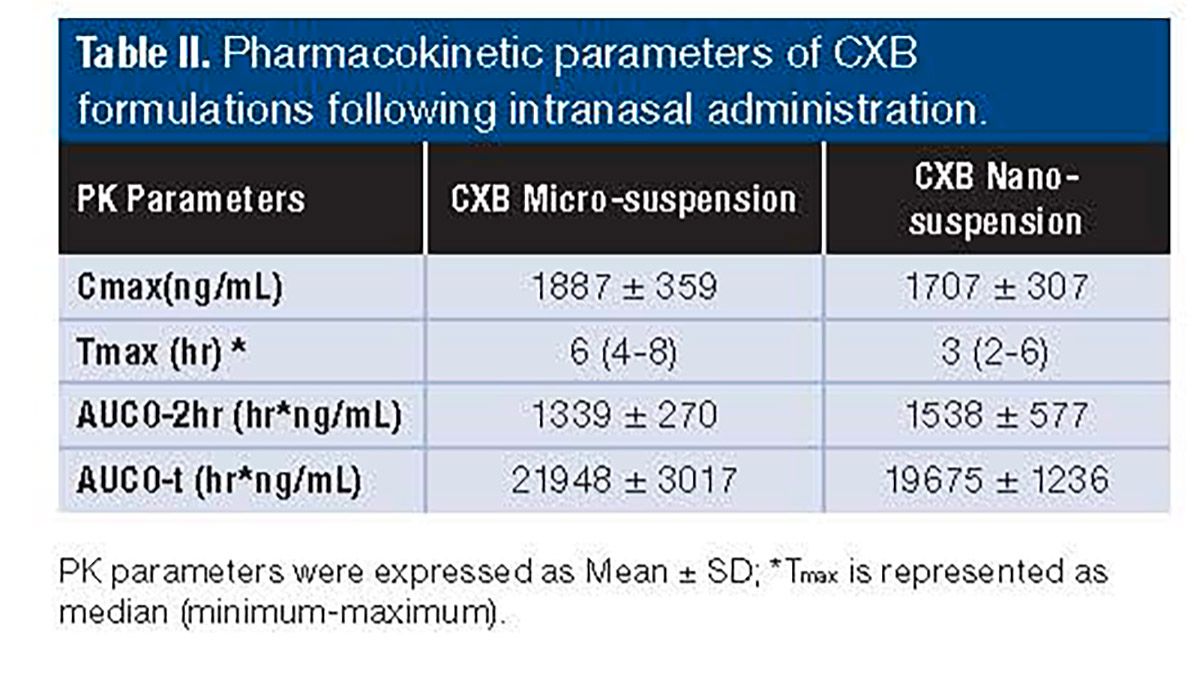
Conclusion
The present study aimed to develop a stable nanosuspension of CXB and assess the impact of CXB particle size on its nasal absorption. Use of controlled precipitation and the selection of stabilizer played significant roles in obtaining stable CXB nanosuspension. These studies record the first documented use of a readily scalable in-line high shear homogenizer for controlled precipitation of CXB, and sodium citrate, a hydrotropic agent as a stabilizer.
Results suggest that nanosized CXB particles are better suited for intranasal delivery than micron-sized particles, because the smaller particles promote rapid drug absorption and help in achieving relatively rapid Tmax and better partial AUCs. These findings are important in improving formulations for treatments that manage acute conditions such as pain and emesis. The concept can be evaluated for other poorly water soluble drugs similar to CXB, and promises to be an area of interest for future research.
Editor's Note
The authors performed this research when they worked together as scientists in the proprietary products department of Dr. Reddy’s Laboratories, Ltd. in Telgana, India. Please address any correspondence to Sandeep Jode (sandipzode@gmail.com; 91-805-406-4151) or Rajasekhar Jaladi (jaladi.rajasekhar@gmail.com).
Submitted: Dec. 19, 2019
Accepted: May 21, 2020
References
1. S. Türker, E. Onur, and Y. Ózer, Pharm World Sci. 26 (3), 137-42 (2004).
2. Y. W. Chien, and S. F. Chang, Crit Rev Ther Drug Carrier Syst. 4 (2), 67-194 (1987).
3. P. Arora, S. Sharma, and S. Garg, Drug Discov Today 7 (18), 967-75 (2002).
4. N. S. Saindane, K. P. Pagar, and P. R. Vavia, AAPS PharmSciTech. 14 (1), 189-99 (2013).
5. P. G. Djupesland, Drug Deliv Transl Res. 3 (1), 42-62 (2013).
6. S. Bhavna, et al., Int. J Biol Macromol. 67, 418-25 (2014).
7. D. Mittal, et al., Drug Deliv. 21 (2), 75-86 (2014).
8. J. Hao, et al., Colloids Surf B Biointerfaces 147, 376-86 (2016).
9. P. Gieszinger, et al., Drug Des Devel Ther. 11, 2453-66 (2017)
10. L. T. Fasiolo, et al., Eur J Pharm Sci. 113, 2-17 (2018).
11.M.T. Vidgren and H. Kublik. Adv Drug Del Rev. 29 (1), 157-77 (1998).
12. P. Gieszinger, et al., Drug Dev Ind Pharm. 44 (10), 1622-30 (2018).
13. L. Pereswetoff-Morath, Adv Drug Del Rev. 29 (1-2), 185-94 (1998).
14. U. Schroeder, et al., J Pharm Sci. 87 (11), 1305-7 (1998).
15. S. Munjal, et al., J Headache Pain 18 (1), 31 (2017).
16. V. Patravale, and R. Kulkarni. J Pharm Pharmacol. 56 (7), 827-40 (2004).
17. R. H. Müller, S. Gohla, C. M. Keck, Eur J Pharm Biopharm. 78 (1), 1-9 (2011).
18. R. Yadollahi, K. Vasilev, and S. Simovic. J Nanomaterials 1, (2015).
19. R. H. Muller, R. Becker, et al., US Patents, US5858410A, 1999.
20. K. Krause, and R. Müller. Int J Pharm. 214 (1), 21-4 (2001).
21. Administration of Drugs and Experimental Compounds in Mice and Rats, bu.edu, Sept. 10, 2018.
22. S. Verma, et al., Int J Pharm. 406 (1), 145-52 (2011).
23. M. Cerdeira and A. Maria, Diss., Eidgenössische Technische Hochschule ETH Zürich, Nr. 20759, 2012.
24. A. Shete, et al., Int J Pharm Sci Res. 1 (1), 51-7 (2010).
25. E. Moghimipour, et al., J Nat Pharm Prod. 9 (2), (2014).
26.J. Salazar, R.H. Müller, and J.P. Möschwitzer, J Pharmaceutics, 2014.
27. Kinematica, Megatron-Dispersing and Mixing Technology by Kinematica, kinematica.ch, Sept. 25, 2018.
28. G.W. Lu, et al., J Pharm Sci. 95 (2), 305-17 (2006).
29. J. Werling, et al., Eur J Pharm Biopharm. 69 (3), 1104-13 (2008).
30. A. Dolenc, et al., Int J Pharm. 376 (1), 204-12 (2009).
31. J. He, et al., RSC Advances 7 (22), 13053-64 (2017). PT
About the authors
Sandeep S. Zode*, sandipzode@gmail.com; 91-805-406-4151, completed his PhD at the National Institute of Pharmaceutical Education and Research, Department of Pharmaceutics, in Punjab, India. He currently works as a senior research scientist in formulation development at Fresenius Kabi India Pvt. Ltd., Gurugram, India. Rajesh Patil, PhD, is currently pharmaceutical development leader at Elanco, formerly a division of Eli Lilly & Company, IN. Piyush Gupta, PhD, is now associate director & lead, pharmaceutics, for Biocon Bristol-Myers Squibb R&D Center (BBRC), Bristol-Myers Squibb India Pvt. Ltd., Bengaluru, India. Rajasekhar Jaladi*, PhD, jaladi.rajasekhar@gmail.com is associate vice president, drug metabolism and pharmacokinetics, for proprietary products, at Dr. Reddy’s. Anirudh Gautam is senior director of R&D, Dr. Reddy’s Switzerland. Rajeev Singh Raghuvanshi, PhD, is senior vice president at Dr. Reddy’s Laboratories Ltd. The authors performed this research when they worked together as scientists in the proprietary products department of Dr. Reddy’s Laboratories, Ltd. in Telgana, India.
* To whom all correspondence should be addressed.
Article details
Pharmaceutical Technology
Vol. 44, No. 9
September 2020
Pages: 36–43
Citation
When referring to this article, please cite it as: S. Zode, R. Patil et al., “Assessment of Nanosuspension Formulation for Intranasal Administration,” PharmTech 44 (9) 2020.
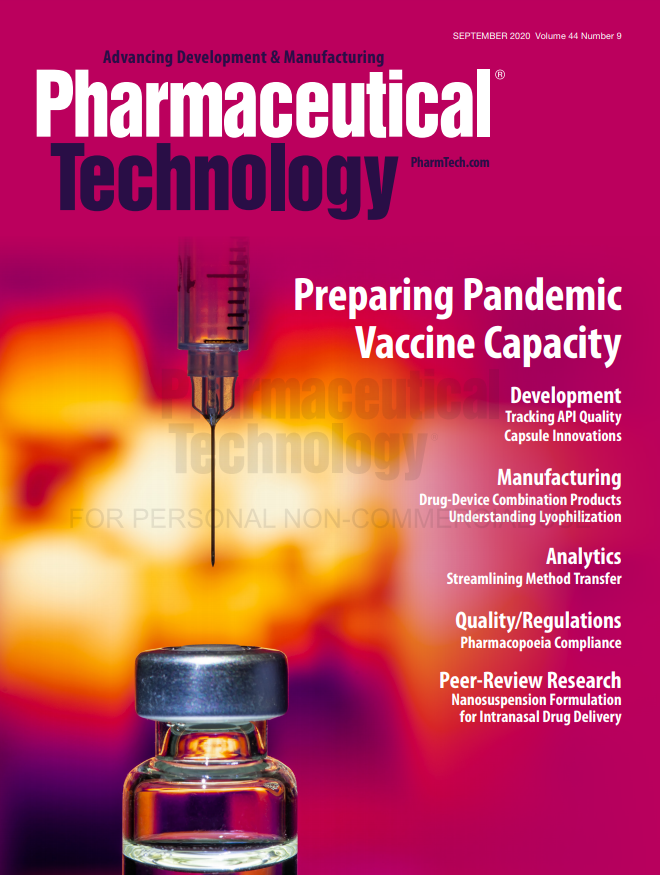
Full Tolerance Coverage Method for Assessing Uniformity of Dosage Units with Large Sample Sizes
March 10th 2025The ‘full tolerance coverage method’ is introduced as a coverage estimation approach for assessing the uniformity of dosage units from large sample sizes, ensuring that no dosage unit exceeds the specification range.
Legal and Regulatory Perspectives on 3D Printing: Drug Compounding Applications
December 10th 2024This paper explores the legal and regulatory framework around 3D drug printing, particularly for personalized medicine, considering regulatory compliance, business concerns, and intellectual property rights.
Determining Low PPB Levels of Nitrite in Polymeric Excipients
September 9th 2024In this paper, the authors introduce a method that combines ion exchange chromatography with an easier-to-perform, simpler one-step post-column derivatization that is selective to nitrite and visible spectrophotometric detection to allow high sample loading volumes without affecting resolution.
The Role of Dry (Water-free) Process Equipment Cleaning in Continuous Pharmaceutical Manufacturing
August 11th 2024The growing use of continuous manufacturing in the pharmaceutical industry merits a review of the application of dry cleaning and sanitization methods, especially for non-sterile oral solid drug product manufacturing of dry powders.